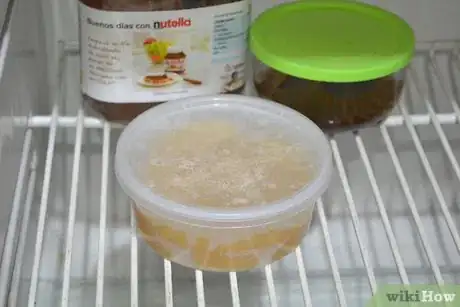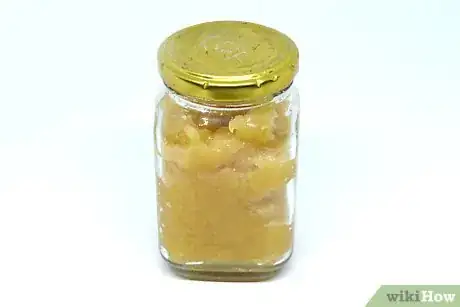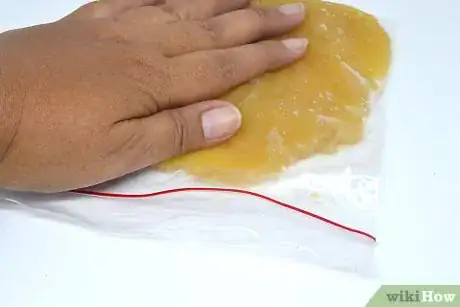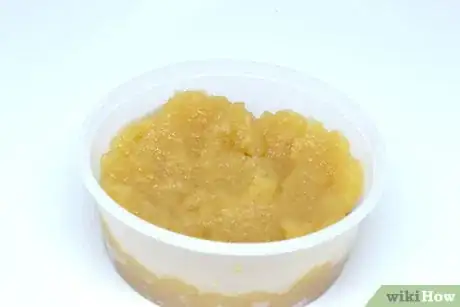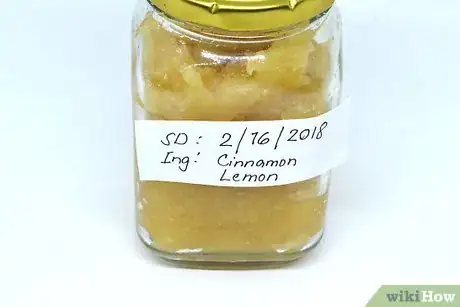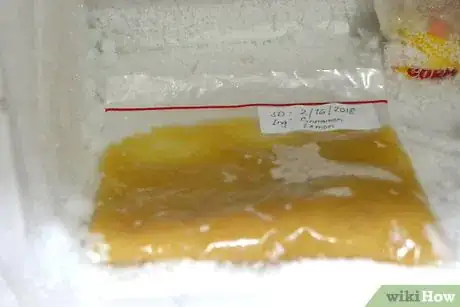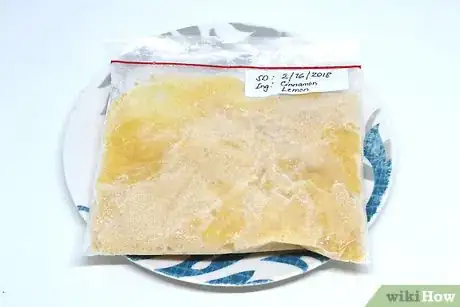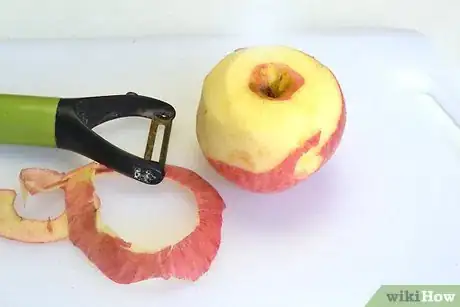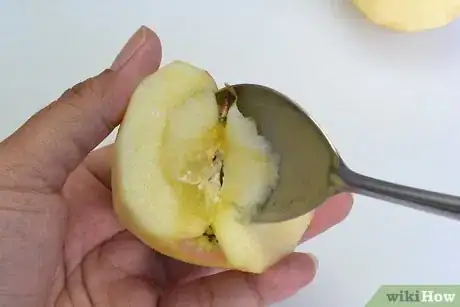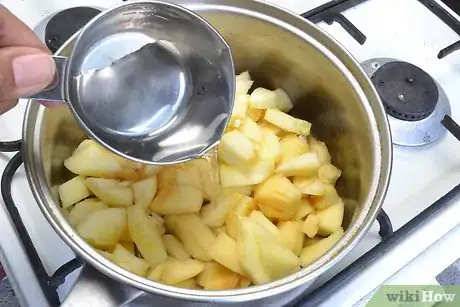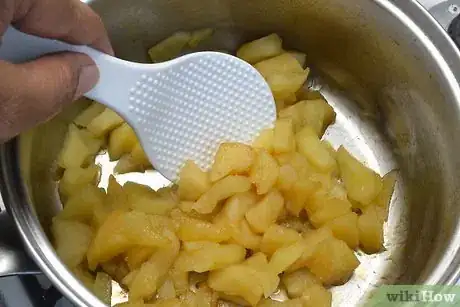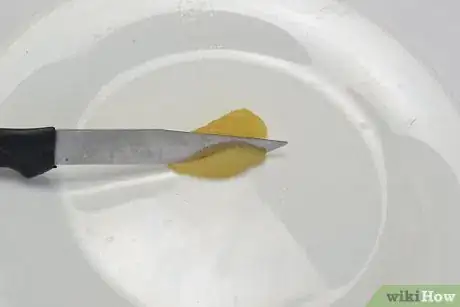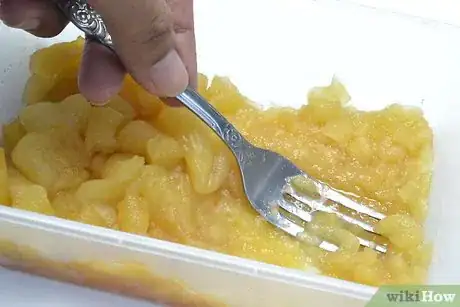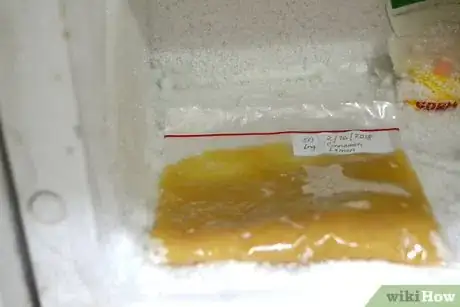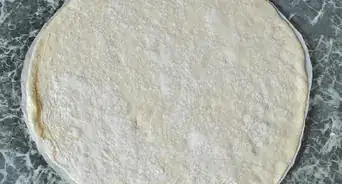This article was co-authored by wikiHow Staff. Our trained team of editors and researchers validate articles for accuracy and comprehensiveness. wikiHow's Content Management Team carefully monitors the work from our editorial staff to ensure that each article is backed by trusted research and meets our high quality standards.
This article has been viewed 54,426 times.
Learn more...
Whether it’s store bought or homemade, applesauce is a great treat for any time of year. Though the sauce only lasts for 1 to 2 weeks after you prepare it, you can extend its shelf life significantly by storing it in a freezer.
Steps
Storing Applesauce in a Freezer
-
1Chill your sauce in the fridge. Pour your applesauce into a shallow pan or bowl, then cover the container and place it inside your refrigerator. Let the sauce sit until it is fully chilled, a process that may take anywhere from 1 hour to 1 day depending on the amount of applesauce you have. Then, remove the bowl from the fridge.
- To see if the sauce is cool enough, dip a spoon into the center of the bowl and remove a small amount of applesauce. If it is cold to the touch, remove the bowl.
-
2Pour your applesauce into a freezer-safe container. For long term storage, you can place your applesauce inside a firm, freezer-safe container, such as a mason jar, or a resealable freezer bag. The container type does not affect the applesauce’s taste or quality, so choose whatever is convenient for you.[1]Advertisement
-
3Squeeze out excess air if you’re using a freezer bag. Place your hands on top of the freezer bag and flatten the applesauce as much as you can. This will help squeeze air out of the sauce, making it easier to store.[2]
-
4Leave 1 inch (2.5 cm) of head space if you’re using a firm container. During freezer storage, your applesauce will grow hard and stick to the edges of your container. This can make opening your jar, tub, or other storage device difficult since your sauce will hold the lid shut. To avoid these issues, leave at least 1 inch (2.5 cm) of space between your applesauce and the top of the container.
-
5Seal and label your container. After pouring the applesauce, place a lid on your storage device or seal the opening shut. Then, place a small label on your container listing the initial storage date and either the brand of applesauce or any ingredients you added to the sauce.[3]
-
6Keep your applesauce in a freezer for up to 2 months. Clear out any section of your freezer and place your applesauce inside. Typically, frozen applesauce will last for up to 2 months, though some homemade varieties will remain good for longer.[4]
-
7Defrost your applesauce when you’re ready to eat it. If you let your sauce thaw in the refrigerator, it should last for another 3 or 4 days. If you thaw your sauce using water or a microwave, eat it immediately so it doesn’t go bad.[5]
Making Homemade Applesauce
-
1Peel each apple and remove their stems. Using a vegetable peeler or knife, slowly peel the skin off each of your apples. If you accidentally slice off part of an apple, put it in a bowl for later use. If any of your apples have stems, pull them off with your fingers.[6]
- When making applesauce, you can use whichever variety of apple you prefer. However, styles like McIntosh, Golden Delicious, Fuji, and Cortland will give your sauce a more traditional flavor.
-
2Cut the apples down the middle. Using a sharp knife, create a straight cut across the very center of each apple. Depending on your cooking preferences, you can either leave your apples in halves or cut them again to create equal quarters.[7]
-
3Remove each apple’s core. In the center of each apple slice, you’ll see a slightly discolored spot that may or may not have seeds in it. This is the apple’s core, which you’ll need to remove before creating your sauce. To do so easily, simply scoop out the core with a spoon and slice off the sections of apple immediately above and below it.[8]
- If you prefer, you can core the apples prior to cutting them using a knife or apple coring device.
-
4Cut the apples into chunks. The size of your apple chunks will determine how fast they cook and how coarse the sauce will be. Small chunks will cook quickly and leave a fairly smooth dish while large chunks will take longer to cook and yield a chunkier sauce. For a good middle ground, try to create chunks that are about 1 in (2.5 cm) thick.[9]
-
5Add water to a cooking pot and set your apples inside. The water will help your apples boil down into a nice paste, giving them that well-known applesauce texture. Put in between .5 in (1.3 cm) and 1 in (2.5 cm) of water for every 12 apples. If your apples seem particularly dry, feel free to add a little more water to the pot, but be aware that too much water will make the sauce mushy and inconsistent.[10]
- Don’t forget to add any pieces of apple you sliced off by accident.
-
6Cook your apples at a medium heat for up to 1 hour, stirring frequently. Place your pot over a burner and set it to a medium temperature. Your cooking time will vary based on how large and juicy the apples are, but most batches should not take more than an hour. To keep your apples from burning, stir them every few minutes.[11]
-
7Take your apples off the heat once you can slice through them easily. You can check on your apples by poking them with a knife. If the blade slices through the apples with no resistance, you’re good to remove them from the heat.[12]
- For safety, give your apples a chance to cool down before moving on.
-
8Mash or blend your apples if necessary. If your apples didn’t boil down quite enough, you can break them up further with some simple kitchen devices. If you want to keep some of the chunky texture, crush your apples up using a potato masher, whisk, fork, or similar item. If you want a smoother texture, run your sauce though a blender or food processor.[13]
-
9Finished.
Community Q&A
-
QuestionCan I freeze apple butter?
 Community AnswerYes, but you have to cure it with heat first. Before you freeze it, set your slow cooker to the lowest temperature (about 800 degrees Fahrenheit). It will start to bubble and evaporate, then precipitate. Scrape from the bottom of the slow cooker, then freeze.
Community AnswerYes, but you have to cure it with heat first. Before you freeze it, set your slow cooker to the lowest temperature (about 800 degrees Fahrenheit). It will start to bubble and evaporate, then precipitate. Scrape from the bottom of the slow cooker, then freeze.
Things You’ll Need
Storing Applesauce
- Applesauce
- Refrigerator
- Freezer
- Pan or bowl
- Freezer-safe container
Making Applesauce
- Apples
- Water
- Vegetable peeler
- Spoon
- Knife
- Cooking pot
- Stovetop or burner
- Potato masher, whisk, or fork (optional)
- Blender or food processor (optional)
References
- ↑ http://untrainedhousewife.com/how-to-make-easy-delicious-and-healthy-freezer-applesauce
- ↑ https://www.midgetmomma.com/freeze-homemade-applesauce/
- ↑ https://www.midgetmomma.com/freeze-homemade-applesauce/
- ↑ http://www.stilltasty.com/Fooditems/index/16388
- ↑ http://www.stilltasty.com/Fooditems/index/16388
- ↑ https://www.thekitchn.com/how-to-make-applesauce-in-the-slow-cooker-223486
- ↑ http://thepioneerwoman.com/cooking/homemade-applesauce/
- ↑ https://www.youtube.com/watch?v=2dQqXqi9Kwk&feature=youtu.be&t=15s
- ↑ https://www.thekitchn.com/how-to-make-applesauce-in-the-slow-cooker-223486
- ↑ http://untrainedhousewife.com/how-to-make-easy-delicious-and-healthy-freezer-applesauce
- ↑ http://untrainedhousewife.com/how-to-make-easy-delicious-and-healthy-freezer-applesauce
- ↑ http://untrainedhousewife.com/how-to-make-easy-delicious-and-healthy-freezer-applesauce
- ↑ http://thepioneerwoman.com/cooking/homemade-applesauce/
About This Article
To successfully freeze applesauce, first set the sauce in a refrigerator to cool. Once it is completely chilled, pour the sauce into a freezer-safe container. If you’re using a firm container, leave a small amount of headroom to keep the lid from freezing shut; if you’re using a freezer bag, make sure to press out any excess air. When you’re ready to store the sauce, seal the container and place a label on it listing the initial freeze date. Then, store it in your freezer for up to 2 months. To learn how to make homemade applesauce, read on!
